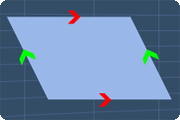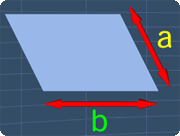Perimeter of a Parallelogram
Lesson Objective
In this lesson, we will learn about the perimeter of a parallelogram.
About This Lesson
In this lesson, we will:
- See an example on finding the perimeter of a parallelogram.
- See another example on finding the side length of a parallelogram.
The study tips and math video below will explain more.

Study Tips
Tip #1
A parallelogram has two pairs of parallel sides and its opposite sides are equal in length. These properties are shown on the right.
Now, if the parallelogram has sides of length a and b, the perimeter of the parallelogram, P, will be:
P = 2(a+b)
This formula is similar to the formula for the perimeter of a rectangle. Rather than repeating the same explanation, the math video below will show some examples on the perimeter of a parallelogram without using the formula.


Math Video
Lesson Video
Sponsored Links
Math Video Transcript
00:00:04.010
In this lesson, we will see some examples on the perimeter of a parallelogram.
00:00:09.220
Consider this parallelogram. We can see that, these 2 parallel sides have the length of 3cm and these 2 parallel sides have the length of 5cm.
00:00:24.030
Find the perimeter of this parallelogram.
00:00:28.070
Now, to find the perimeter of the parallelogram, P, we just add the length of these sides together.
00:00:36.110
Hence, we have P, equals to 3, add with 5, add with another 3, and add with another 5.
00:00:51.230
Therefore, we have P=3+5+3+5.
00:00:59.020
Let's calculate this. 3, add with 5, gives 8. 5, add with 8, gives 13. 3, add with 13, gives 16.
00:01:15.140
Hence, we have P=16.
00:01:20.120
Now, this number has no meaning, unless we include the unit for it.
00:01:26.070
Since the side lengths are given in centimeter, the perimeter must also be in centimeter.
00:01:32.210
Hence, the perimeter of this parallelogram is 16cm.
00:01:40.120
Next example, the perimeter of this parallelogram is 30ft. Find x.
00:01:50.040
Here, we can see that, this parallelogram has 2 parallel sides of length 8 feet, and, another 2 parallel sides of length x.
00:02:01.180
Now, we can find the perimeter of the parallelogram, by adding all the side lengths together.
00:02:08.240
By doing so, we have x, add with 8, add with another x, and add with another 8.
00:02:26.120
Since the perimeter is given as 30ft, this expression must be equals to, 30.
00:02:33.180
Before we continue, let's arrange the like terms together.
00:02:39.090
Now, let's simplify this equation. 8, add with 8, gives 16.
00:02:48.040
x, add with x, gives 2x.
00:02:53.000
Now, we have 2x+16=30.
00:02:59.160
To get a step closer in finding x, we need to remove 16.
00:03:05.120
To do so, we add -16 to both sides of the equation.
00:03:11.010
By doing so, we get, 2x equals to, 30 minus 16. 30, minus 16, gives 14.
00:03:24.170
Next, to find x, we need to remove 2. We can do so, by dividing both sides of the equation with 2.
00:03:36.170
By doing so, we get, x=14/2.
00:03:44.080
14, divided by 2, gives 7. Hence, we have, x=7.
00:03:55.010
Again, this number has no meaning unless we include the unit for it.
00:04:00.170
Since, the unit is in feet, 7 will also be in feet.
00:04:06.230
Finally, we have, x=7ft.
00:04:13.220
That is all for this lesson. Try out the practice question to further your understanding.
Practice Questions & More
Multiple Choice Questions (MCQ)
Now, let's try some MCQ questions to understand this lesson better.
You can start by going through the series of questions on the perimeter of a parallelogram or pick your choice of question below.
- Question 1 on finding the perimeter of a parallelogram
- Question 2 on finding side length of a parallelogram
Site-Search and Q&A Library
Please feel free to visit the Q&A Library. You can read the Q&As listed in any of the available categories such as Algebra, Graphs, Exponents and more. Also, you can submit math question, share or give comments there.


